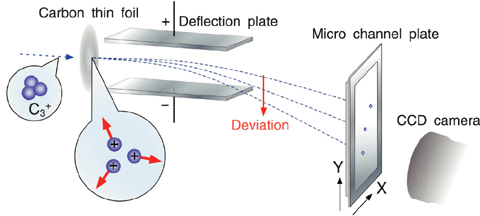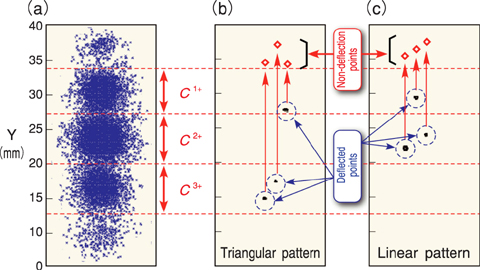
Fig.14-19 Apparatus for simultaneous measurement of charge-state and spatial pattern of a cluster ion

Fig.14-20 Two patterns of correlation of the deflected points and the non-deflection points
Table14-1 Average charges of the fragment ions arising from the dissociation of a C3+ cluster ion passing through a thin carbon foil, estimated experimentally and theoretically

Studies on material science and biotechnology for various ion beams with an energy ranging from 30 keV to hundreds of MeV are in progress in the Takasaki advanced radiation research institute. Understanding the interaction between an incident ion and a target is indispensable for selection of suitable experimental conditions, i.e., an incident ion species, its energy, and a target, and analyses of experimental results. The interaction for irradiation with mono-atomic ion has been investigated from the early days, and some models have succeeded in explaining most of experimental results. However, various strange phenomena out of such models have been observed for irradiation with a swift cluster ion consisting of a number of atoms for example, secondary-ion or secondary-electron emission.
When a swift cluster ion impinges on a matter, a lot of atoms are brought into a very small volume simultaneously therefore, vicinal fragment ions interact with each other even after the dissociation of the cluster. In this process, a spatial pattern of the cluster constituents could affect their interactions with a matter. The effect of the spatial pattern on charge-state distribution of fragment ions arising from the dissociation of a cluster passing through a thin foil was investigated, to make a new model for the interaction between a cluster ion and a matter.
A new apparatus as shown in Fig.14-19, was developed for the investigation. Ions emerging from a thin carbon foil deflected depending on their charge-state by an electrostatic deflector placed between the foil and a micro channel plate (MCP). A two-dimensional pattern of the deflected ions was observed as luminance points on a fluorescent screen equipped with the MCP. The apparatus enables us to measure the charge-state of each fragment ion of a cluster ion and their spatial pattern, just after emerging from the foil simultaneously, as shown in Fig.14-20. The charge-state distribution of fragment ions of a 3-MeV C3+ was measured for different patterns, i.e., a linear-chain pattern and an equilateral triangular pattern after emerging from the foil.
The results are summarized in Table14-1. The cluster average charge obtained for the liner-chain pattern is larger than that for the triangular pattern, and the average charge of two edge-position ions in a liner-chain pattern is larger than that of the middle-position ion. The theoretical average charge of the fragment ions of a C3+ ion was calculated considering the effect of the nuclear charge of the other neighboring fragments on the binding energy of the valence electrons, and the spatial pattern of the fragments, a repulsive Coulomb force among the fragment ions, a wake force induced by each fragment and etc., were taken into account in the calculation. The obtained average charges are qualitatively consistent with the experimental results as shown in Table14-1.
Although the measurement of the charge-state distribution of fragment ions have been done by other researchers so far, this is the first time measurements were performed by classifying the special pattern of the fragment ions. The interaction between a swift cluster ion and a matter correlates with the spatial pattern of the constituents in a cluster, which should be demonstrated as one of the most characteristic of the cluster-matter interaction.